Effects of the Shot Peening Process on Corrosion Resistance of Aluminum Alloy: A Review
Abstract
:1. Introduction
2. Strengthening Mechanism of Shot Peening Process
3. Effect of the Shot Peening Process on Surface Integrity of Aluminum Alloy
3.1. Surface Roughness
3.2. Residual Stress
3.3. Surface Microhardness
4. Effect of a Deformed Surface Layer on Corrosion Resistance of Aluminum Alloy
4.1. Surface Roughness
4.2. Residual Stress
4.3. Microstructure
5. Summary and Outlook
Author Contributions
Funding
Institutional Review Board Statement
Informed Consent Statement
Data Availability Statement
Conflicts of Interest
References
- Santos, M.C.; Machado, A.R.; Sales, W.F.; Barrozo, M.A.S.; Ezugwu, E.O. Machining of aluminum alloys: A review. Int. J. Adv. Manuf. Tech. 2016, 86, 3067–3080. [Google Scholar] [CrossRef]
- Hirsch, J. Aluminium in innovative light-weight car design. Mater. Trans. 2011, 52, 818–824. [Google Scholar] [CrossRef] [Green Version]
- Robinson, J.S.; Pirling, T.; Truman, C.E.; Panzner, T. Residual stress relief in the aluminium alloy 7075. Mater. Sci. Technol. 2017, 33, 1765–1775. [Google Scholar] [CrossRef]
- López-Ortega, A.; Areitioaurtena, O.; Alves, S.A.; Goitandia, A.M.; Elexpe, I.; Arana, J.L.; Bayón, R. Development of a super-hydrophobic and bactericide organic topcoat to be applied on thermally sprayed aluminum coatings in offshore submerged components. Prog. Org. Coat. 2019, 137, 105376. [Google Scholar] [CrossRef]
- Mariana, P.M.V.; Abrahami, S.T.; Hack, T.; Malte, B.; Herman, T. A review on anodizing of aerospace aluminum alloys for corrosion protection. Coatings 2020, 10, 1106. [Google Scholar]
- Zhang, B.; Fang, Z.; Li, X.Y.; Dong, C.C. Current status and prospect of corrosion protection technology for aluminum alloy ships. China Mater. Prog. 2014, 33, 414–417. (In Chinese) [Google Scholar]
- Qiu, C.J.; Zhou, X.J.; Shi, Z.B.; Liu, H.J. Fracture analysis of steam huff and puff pipeline in a well in Bohai Sea. Coat. Prot. 2019, 40, 16–26. (In Chinese) [Google Scholar]
- Soares, C.G.; Garbatov, Y.; Zayed, A.; Wang, G. Influence of environmental factors on corrosion of ship structures in marine atmosphere. Corros. Sci. 2009, 51, 2014–2026. [Google Scholar] [CrossRef]
- Li, B.; Dong, L.H.; Wang, H.D.; Zhou, Y.X.; Gao, C. Research Progress on Corrosion Fatigue of Aerospace Aluminum Alloy. Surf. Technol. 2021, 50, 106–118. (In Chinese) [Google Scholar]
- Niu, J.T.; Liu, Z.Q.; Wang, G.J.; Huang, W.M.; Xu, Y. Anticorrosion property enhancement of Al–Li alloy 2A97 by lowering machined surface roughness. Mater. Corros. 2020, 71, 1980–1988. [Google Scholar] [CrossRef]
- Chen, G.J.; Hou, S.; Han, S.X. Research Progress on the Influence of Machining Surface Quality on corrosion Resistance. Surf. Technol. 2019, 48, 25–33. (In Chinese) [Google Scholar]
- Bhat, K.U.; Panemangalore, D.B.; Kuruveri, S.B.; John, M.; Menezes, P.L. Surface Modification of 6xxx Series Aluminum Alloys. Coatings 2022, 12, 180. [Google Scholar] [CrossRef]
- Wang, H.; Ning, C.; Huang, Y.; Cao, Z.; Chen, X.; Zhang, W. Improvement of abrasion resistance in artificial seawater and corrosion resistance in NaCl solution of 7075 aluminum alloy processed by laser shock peening. Opt. Lasers Eng. 2017, 90, 179–185. [Google Scholar] [CrossRef]
- Cheng, J.C.; Zhou, X.Y.; Zhou, T.; Zhang, Y.W.; Yang, T. Research Status and Prospect of Surface Strengthening Technology for Automotive Parts. Surf. Technol. 2015, 44, 68–75. (In Chinese) [Google Scholar]
- Deng, H.H.; Xia, Q.X.; Cheng, X.Q.; Ren, Y.P. Effect of shot peening on fatigue properties of pre-corroded aluminum alloy. Surf. Technol. 2016, 45, 118–123. (In Chinese) [Google Scholar]
- Meyer, D.; Hettig, M.; Mensching, N. Pulsed Mechanical Surface Treatment—An Approach to Combine the Advantages of Shot Peening, Deep Rolling, and Machine Hammer Peening. J. Manuf. Mater. Process. 2021, 5, 98. [Google Scholar] [CrossRef]
- Jerez-Mesa, R.; Llumà, J.; Travieso-Rodríguez, J.A. Vibration-Assisted Ball Burnishing. Encyclopedia 2021, 1, 460–471. [Google Scholar] [CrossRef]
- Maamoun, A.H.; Elbestawi, M.A.; Veldhuis, S.C. Influence of Shot Peening on AlSi10Mg Parts Fabricated by Additive Manufacturing. J. Manuf. Mater. Process. 2018, 2, 40. [Google Scholar] [CrossRef] [Green Version]
- Lei, C.; Chen, X.; Li, Y.; Chen, Y.; Yang, B. Enhanced Corrosion Resistance of SA106B Low-Carbon Steel Fabricated by Rotationally Accelerated Shot Peening. Metals 2019, 9, 872. [Google Scholar] [CrossRef] [Green Version]
- Kumar, P.; Mahobia, G.S.; Mandal, S.; Singh, V.; Chattopadhyay, K. Enhanced corrosion resistance of the surface modified Ti-13Nb-13Zr alloy by ultrasonic shot peening. Corros. Sci. 2021, 189, 109597. [Google Scholar] [CrossRef]
- Azhari, A.; Sulaiman, S.; Rao, A.K.P. A review on the application of peening processes for surface treatment. IOP. Conf. Ser. Mater. Sci. Eng. 2016, 114, 012002. [Google Scholar] [CrossRef] [Green Version]
- Zhang, S.B.; Bu, Z.Y. Finite Element Simulation of residual stress field of 2024 Aluminum Alloy after random multi-shot peening. Mater. Mech. Eng. 2016, 40, 87–90. [Google Scholar]
- Wang, R.Z. Review on Shot Peening Strengthening Mechanism of Metallic Materials. China Surf. Eng. 2012, 25, 1–9. (In Chinese) [Google Scholar]
- Wang, C.; Jiang, C.; Ji, V. Thermal stability of residual stresses and work hardening of shot peened tungsten cemented carbide. J. Mater. Process. Techonl. 2017, 240, 98–103. [Google Scholar] [CrossRef]
- Bagherifard, S.; Ghelichi, R.; Guagliano, M. On the shot peening surface coverage and its assessment by means of finite element simulation: A critical review and some original developments. Appl. Surf. Sci. 2012, 259, 186–194. [Google Scholar] [CrossRef]
- Lin, Q.J.; Liu, H.J.; Zhu, C.C.; Parker, R.G. Investigation on the effect of shot peening coverage on the surface integrity. Appl. Surf. Sci. 2019, 489, 66–72. [Google Scholar] [CrossRef]
- Trsko, L.; Guagliano, M.; Lukac, P.; Bokuvka, O.; Novy, F. Effects of severe shot peening on the surface state of AW 7075 Al alloy. Kovove. Mater. Met. Mater. 2015, 53, 239–243. [Google Scholar] [CrossRef] [Green Version]
- John, M.; Kalvala, P.R.; Misra, M.; Menezes, P.L. Peening techniques for surface modification: Processes, properties, and applications. Materials 2021, 14, 3841. [Google Scholar] [CrossRef]
- Cho, K.T.; Song, K.; Oh, S.H.; Lee, Y.K.; Lim, K.M.; Lee, W.B. Surface hardening of aluminum alloy by shot peening treatment with Zn based ball. Mater. Sci. Eng. A. 2012, 543, 44–49. [Google Scholar] [CrossRef]
- Kikuchi, S.; Nakamura, Y.; Nambu, K.; Ando, M. Effect of shot peening using ultra-fine particles on fatigue properties of 5056 aluminum alloy under rotating bending. Mater. Sci. Eng. A. 2016, 652, 279–286. [Google Scholar] [CrossRef] [Green Version]
- Valiev, R.Z.; Estrin, Y.; Horita, Z.; Langdon, T.G.; Zehetbauer, M.J.; Zhu, Y. Producing Bulk Ultrafine-Grained Materials by Severe Plastic Deformation: Ten Years Later. JOM 2016, 68, 1216–1226. [Google Scholar] [CrossRef] [Green Version]
- Gao, Y.K.; Zhao, Z.Y. Surface Integrity of Gear and Development Trend of Anti-Fatigue Manufacturing Technology. Heat. Treat. Met. 2014, 39, 1–6. (In Chinese) [Google Scholar]
- Niu, J.T.; Liu, Z.Q.; Wang, B.; Hua, Y.; Wang, G.J. Effect of machining-induced surface integrity on the corrosion behavior of Al–Li alloy 2A97 in sodium chloride solution. Mater. Corros. 2019, 70, 259–267. [Google Scholar] [CrossRef]
- Niu, J.T.; Liu, Z.Q.; Wang, G.J. Comparative Study on Electrochemical Behavior of Al-Li Alloy 2A97 Machined Surfaces in Sodium Chloride Solution. IEEE. Access. 2019, 7, 134198–134205. [Google Scholar] [CrossRef]
- Clauer, A.H. Laser shock peening, the path to production. Metals 2019, 9, 626. [Google Scholar] [CrossRef] [Green Version]
- Gujba, A.K.; Medraj, M. Laser peening process and its impact on materials properties in comparison with shot peening and ultrasonic impact peening. Materials 2014, 7, 7925–7974. [Google Scholar] [CrossRef] [Green Version]
- Marteau, J.; Bigerelle, M.; Mazeran, P.E.; Bouviera, S. Relation between roughness and processing conditions of AISI 316L stainless steel treated by ultrasonic shot peening. Tribol. Int. 2015, 82, 319–329. [Google Scholar] [CrossRef]
- Ding, X.; Kang, Y.; Li, D.; Wang, X.C.; Zeng, D.P. Experimental investigation on surface quality processed by self-excited oscillation pulsed waterjet peening. Materials 2017, 10, 989. [Google Scholar] [CrossRef] [Green Version]
- Yang, L.; Huang, G.Z.; Zhou, B.; Zhang, C.; Bai, D. Effect of shot peening on corrosion resistance of 6082 aluminum alloy (in Chinese). Heat Treat. Met. 2019, 44, 161–166. [Google Scholar]
- Nam, Y.S.; Jeong, Y.I.; Shin, B.C.; Byun, J.H. Enhancing surface layer properties of an aircraft aluminum alloy by shot peening using response surface methodology. Mater. Des. 2015, 83, 566–576. [Google Scholar] [CrossRef]
- Gao, Y.K.; Wu, X.R. Experimental investigation and fatigue life prediction for 7475-T7351 aluminum alloy with and without shot peening-induced residual stresses. Acta Mater. 2011, 59, 3737–3747. [Google Scholar] [CrossRef]
- González, J.; Bagherifard, S.; Guagliano, M.; Pariente, I.F. Influence of different shot peening treatments on surface state and fatigue behavior of al 6063 alloy. Eng. Fract. Mech. 2017, 185, 72–81. [Google Scholar] [CrossRef]
- Win, K.N.; Quang, T.P.; Lee, B.D. Study on hardness and wear resistance of shot peened AA7075-T6 aluminum alloy. Eng. Res. Express. 2021, 3, 015031. [Google Scholar]
- Pandey, V.; Chattopadhyay, K.; Srinivas, S.N.C.; Singh, V. Role of ultrasonic shot peening on low cycle fatigue behavior of 7075 aluminum alloy. Int. J. Fatigue 2017, 103, 426–435. [Google Scholar] [CrossRef]
- Gao, Z.; Liao, K.; Chen, J. Surface Characteristic Function of Al Alloy after Shot Peening. Coatings 2021, 11, 160. [Google Scholar] [CrossRef]
- Zhang, J.R.; Chang, X.Q.; Sheng, X.F.; Cheng, Z.C.; Xia, Q.X. Effect of shot peening on surface roughness of 7075 aluminum alloy. Light. Alloy. Manuf. Technol. 2014, 42, 54–59. (In Chinese) [Google Scholar]
- Sheng, X.; Xia, Q.; Cheng, X.; Lin, L.S. Residual stress field induced by shot peening based on random-shots for 7075 aluminum alloy. T. Nonferr. Metal. Soc. 2012, 22, 261–267. (In Chinese) [Google Scholar] [CrossRef]
- Liu, C.W.; Liao, K.; Chen, J.W.; Li, L.J. Simulation and Experimental Study on Effect of Shot Peening on Surface Roughness of 7075-T651 Aluminum Alloy. Trans. Mater. Heat Treat. 2021, 42, 172–180. (In Chinese) [Google Scholar]
- Trško, L.; Guagliano, M.; Bokůvka, O.; Nový, F.; Jambor, M.; Florková, Z. Influence of severe shot peening on the surface state and ultra-high-cycle fatigue behavior of an AW 7075 aluminum alloy. J. Mater. Eng. Perform. 2017, 26, 2784–2797. [Google Scholar] [CrossRef]
- Wang, Y.J.; Sun, B.L.; Zhang, W.; Gao, G.Q.; Qiao, M.J. Numerical simulation and experiment of shot peening strengthening of al-li alloy. J. Aerosp. Power 2015, 30, 595–602. (In Chinese) [Google Scholar]
- Miao, H.Y.; Mann, P.; Gariépy, A.; Lévesque, M.; Chromik, R.R. Residual stress near single shot peening impingements determined by nanoindentation and numerical simulations. J. Mater. Sci. 2015, 50, 2284–2297. [Google Scholar]
- Lawerenz, M.D. Shot Peening and its Effect on Gearing. SAE. Tech. Pap. 1984, 93, 1023–1033. [Google Scholar]
- Zhao, Y.X.; Liu, D.X.; Guan, Y.Y.; Cheng, S.M.; Du, D.X.; Li, P.; Liu, H.B.; Wang, Y.H. Influence of ceramic peening on fatigue properties of 2024HDT aluminum alloy. Ordnance. Mater. Sci. Eng. 2014, 37, 15–20. (In Chinese) [Google Scholar]
- Zeng, W.; Yang, J. Quantitative representation of mechanical behaviour of the surface hardening layer in shot-peened nickel-based superalloy. Materials 2020, 13, 1437. [Google Scholar] [CrossRef] [Green Version]
- Li, B. Comparative Experimental study on different Surface strengthening processes of 7075 Aluminum Alloy. Light. Alloy. Process. Technol. 2016, 44, 36–40. (In Chinese) [Google Scholar]
- Zhu, L.H.; Guan, Y.J.; Wang, Z.S.; Zheng, H.Y.; Lin, J.; Zhai, J.Q.; Xie, Z.D. Influence of Surface Nanocrystallization and Partial Amorphization Induced by Ultrasonic Shot Peening on Surface Properties of 7075 Aluminum Alloy. J. Mater. Eng. Perform. 2020, 29, 7693–7709. [Google Scholar] [CrossRef]
- Avcu, Y.Y.; Gönül, B.; Yetik, O.; Sönmez, F.; Cengiz, A.; Guney, M.; Avcu, E. Modification of Surface and Subsurface Properties of AA1050 Alloy by Shot Peening. Materials 2021, 14, 6575. [Google Scholar] [CrossRef]
- Li, L.J.; Li, Y.S. Effect of shot peening duration on mechanical properties and microstructure of 5052 al-mg alloy. Hot Working Technol. 2018, 47, 93–96. (In Chinese) [Google Scholar]
- Tao, X.F.; Gao, Y.K.; Kang, J.M.; Wang, Y.W. Softening effects induced by shot peening for an aluminum-lithium alloy. Metall. Mater. Trans. A 2020, 51, 410–418. [Google Scholar] [CrossRef]
- Yang, F.B.; He, Y.F.; Li, D.Q.; Zhu, Q. Salt Spray Corrosion Resistance of SSM319s Aluminum Alloy with Surface Blast Treatment. Rare. Met. 2014, 38, 941–947. (In Chinese) [Google Scholar]
- Ye, Z.Y.; Liu, D.X.; Wu, J. Effect of Shot peening and Stress Factors on Denudation Behavior of 2E12-T3 Aluminum Alloy. Corros. Sci. Prot. Technol. 2013, 25, 445–450. (In Chinese) [Google Scholar]
- Pandey, V.; Singh, J.K.; Chattopadhyay, K.; Santhi Srinivas, N.C.; Singh, V. Optimization of USSP duration for enhanced corrosion resistance of AA7075. Ultrasonics 2019, 91, 180–192. [Google Scholar] [CrossRef] [PubMed]
- Sun, Q.Q.; Liu, X.T.; Han, Q.Y.; Li, J.; Xu, R.; Zhao, K.J. A comparison of AA2024 and AA7150 subjected to ultrasonic shot peening: Microstructure, surface segregation and corrosion. Surf. Coat. Technol. 2018, 337, 552–560. [Google Scholar] [CrossRef]
- Sun, Q.Q.; Han, Q.Y.; Wang, S.; Xu, R. Microstructure, corrosion behaviour and thermal stability of AA 7150 after ultrasonic shot peening. Surf. Coat. Technol. 2020, 398, 126127. [Google Scholar] [CrossRef]
- Lee, H.S.; Kim, D.S.; Jung, J.S.; Pyoun, Y.S.; Shin, K. Influence of peening on the corrosion properties of AISI 304 stainless steel. Corros. Sci. 2009, 51, 2826–2830. [Google Scholar] [CrossRef]
- Hadzima, B.; Bukovina, M.; Dolezal, P. Shot peening influence on corrosion resistance of AE21 magnesium alloy. Mater. Eng. 2010, 17, 14–19. [Google Scholar]
- He, W.; Wang, Y.N.; Liu, J.S.; Wang, Y.L.; Tan, J.G.; Gao, J. Effect of rotating shot peening on stress corrosion resistance of 7b04-t6 aluminum alloy. J. Aeronaut. Mater. 2020, 40, 52–58. (In Chinese) [Google Scholar]
- Mhaede, M. Influence of surface treatments on surface layer properties, fatigue and corrosion fatigue performance of AA7075 T73. Mater. Design. 2012, 41, 61–66. [Google Scholar] [CrossRef]
- Pandey, V.; Singh, J.K.; Chattopadhyay, K. Influence of ultrasonic shot peening on corrosion behavior of 7075 aluminum alloy. J. Aalloy. Compd. 2017, 723, 826–840. [Google Scholar] [CrossRef]
- Trdan, U.; Grum, J. Evaluation of corrosion resistance of AA6082-T651 aluminium alloy after laser shock peening by means of cyclic polarisation and ElS methods. Corros. Sci. 2012, 59, 324–333. [Google Scholar] [CrossRef]
- Lv, S.L.; Cu, Y.; Zhang, W.; Tong, X.Y.; Srivatsan, T.S.; Gao, X.S. Influence of shot peening on failure of an aluminum alloy exposed to aggressive aqueous environments. J. Mater. Eng. Perform. 2013, 22, 1735–1743. [Google Scholar] [CrossRef]
- Wang, J.T.; Zhang, Y.K.; Chen, J.F.; Zhou, J.Y.; Lu, Y.L.; Zhang, C.Y. Effect of High Intensity Laser Shock on electrochemical Corrosion Behavior of Plasma Arc Welding joints of 7075 Aluminum Alloy. Chin. J. Lasers. 2015, 12, 106–115. (In Chinese) [Google Scholar]
- Abdulstaar, M.; Mhaede, M.; Wollmann, M.; Wagner, L. Investigating the effects of bulk and surface severe plastic deformation on the fatigue, corrosion behaviour and corrosion fatigue of AA5083. Surf. Coat. Tech. 2014, 254, 244–251. [Google Scholar] [CrossRef]
- Fern, I. TEM evaluation of steel nanocrystalline surfaces obtained by severe shot peening. Surf. Coat. Technol. 2021, 418, 127238. [Google Scholar]
- Bagheri, S.; Guagliano, M. Review of shot peening processes to obtain nanocrystalline surfaces in metal alloys. Surf. Eng. 2009, 25, 3–14. [Google Scholar] [CrossRef]
- Su, L.; Lu, C.; Li, H.; Deng, G.; Tieu, K. Investigation of ultrafine grained AA1050 fabricated by accumulative roll bonding. J. Mater. Sci. Eng. A. 2014, 614, 148–155. [Google Scholar] [CrossRef] [Green Version]
- Bagherifard, S. Enhancing the structural performance of lightweight metals by shot peening. Adv. Eng. Mater. 2019, 21, 1801140. [Google Scholar] [CrossRef]
- Amini, S.; Kariman, S.A.; Teimouri, R. The effects of ultrasonic peening on chemical corrosion behavior of aluminum 7075. Int. J. Adv. Manuf. Tech. 2017, 91, 1091–1102. [Google Scholar] [CrossRef]
- Zhou, K.; Yang, Y. Effect of laser shot peening on microstructure and stress corrosion resistance of 2195 Al-Li alloy. Al. Fab. 2019, 2, 10–14. (In Chinese) [Google Scholar]
- Lv, Y.T.; Zhao, B.J.; Zhang, H.B.; Su, C.J.; Nie, B.; Wang, R.; Cao, L.M.; Lyu, F.Y. Improving Corrosion Resistance Properties of Nickel-Aluminum Bronze (NAB) Alloys via Shot Peening Treatment. Mater. Trans. 2019, 60, 1629–1637. [Google Scholar] [CrossRef] [Green Version]
- Niu, J.T.; Liu, Z.Q.; Qiao, Y.; Wang, X.Y.; Chen, H.T. Novel combination of indicators to compare the corrosion behaviors of Al, Al–Li alloy 2A97, and other Al alloys. Mater. Corros. 2022, 73, 171–179. [Google Scholar] [CrossRef]
- Deng, Y.H.; Liu, J.; Qiao, Y.; Niu, J.T. Comparative investigations on the electrochemical behaviors among Al and aluminum alloys. Mater. Res. Express. 2020, 7, 116510. [Google Scholar] [CrossRef]
- Prakash, N.A.; Gnanamoorthy, R.; Kamaraj, M. Surface nanocrystallization of aluminium alloy by controlled ball impact technique. Surf. Coat. Tech. 2012, 210, 78–89. [Google Scholar] [CrossRef]
- Chen, J.S.; Desai, D.A.; Heyns, S.P.; Pietra, F. Literature review of numerical simulation and optimisation of the shot peening process. Adv. Mech. Eng. 2019, 11, 1–19. [Google Scholar] [CrossRef]
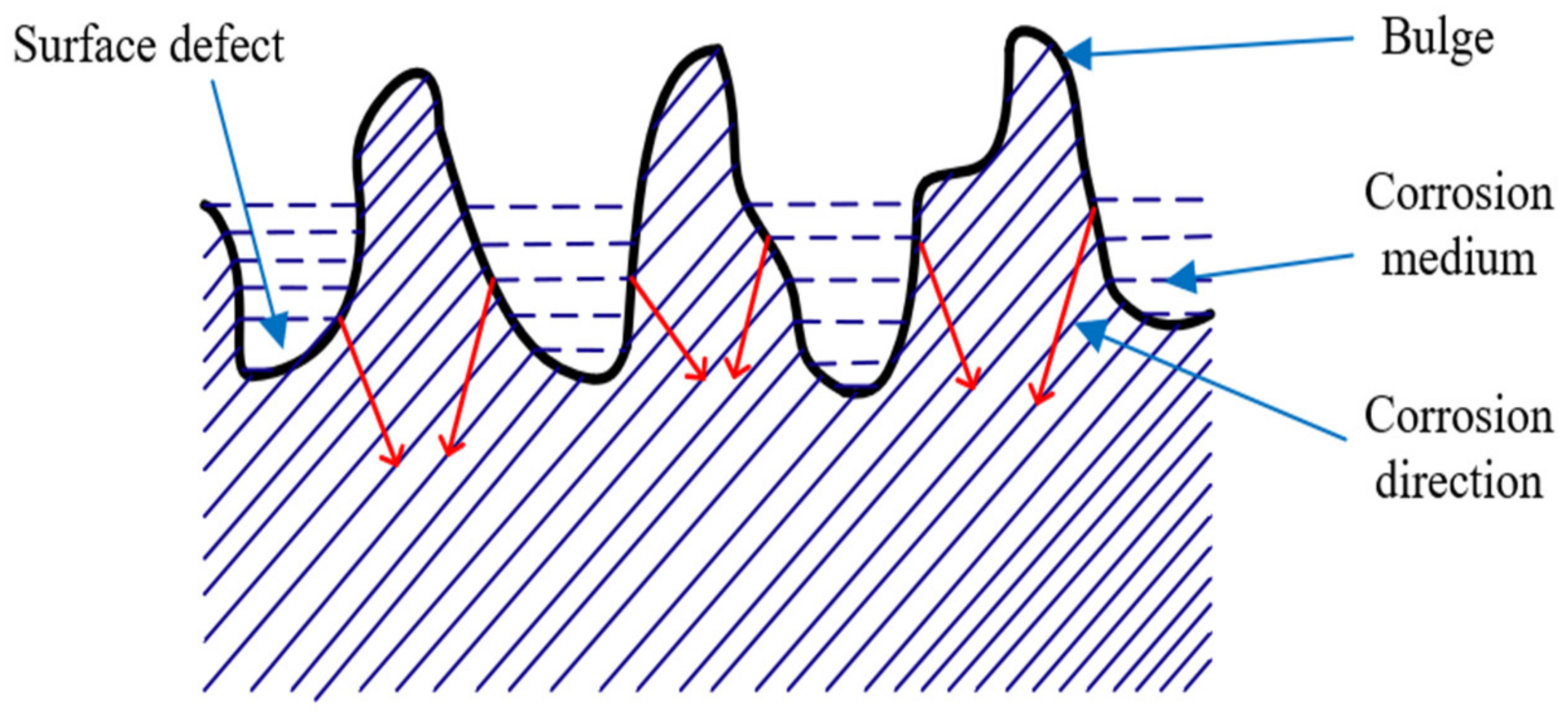



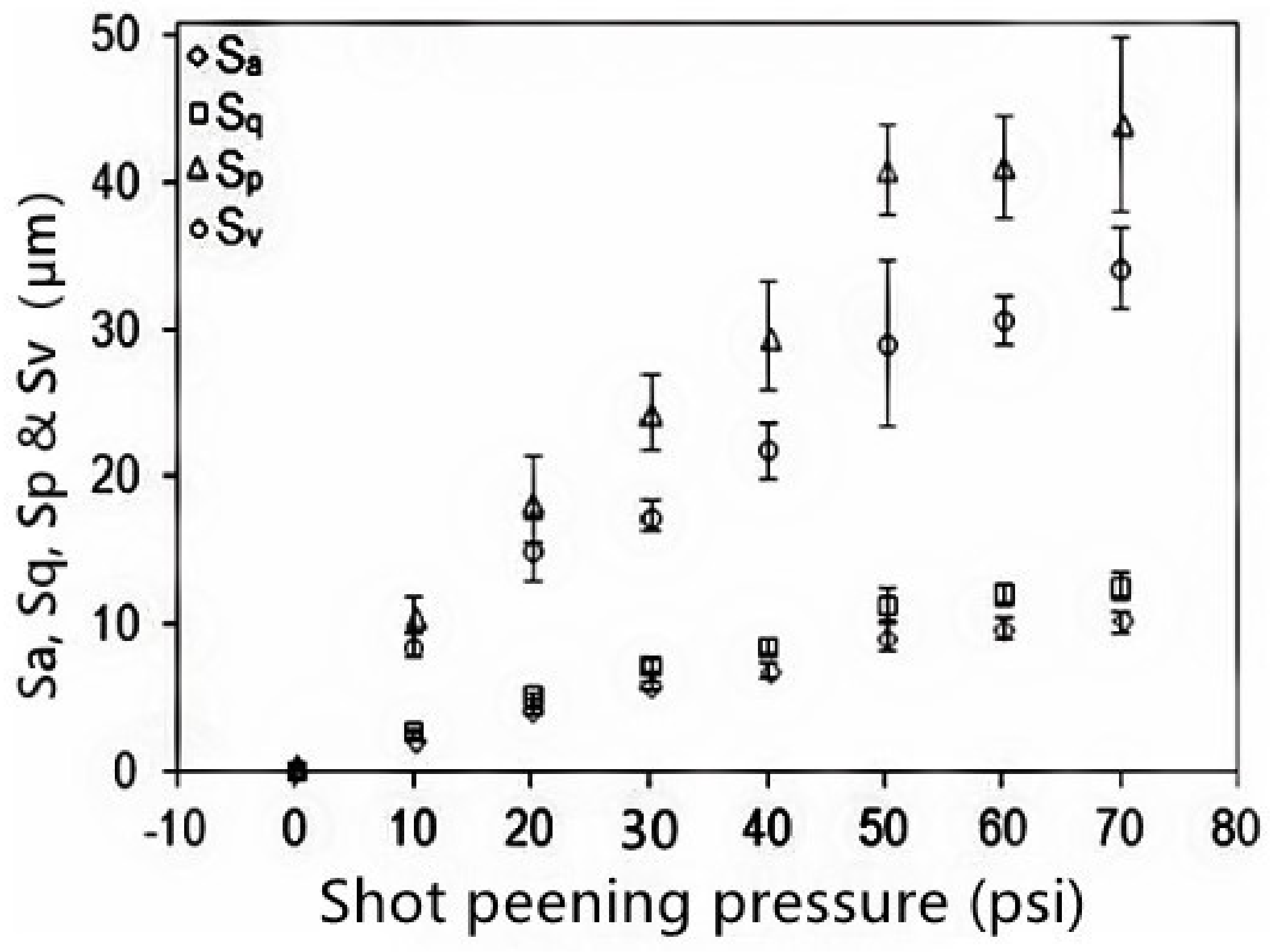
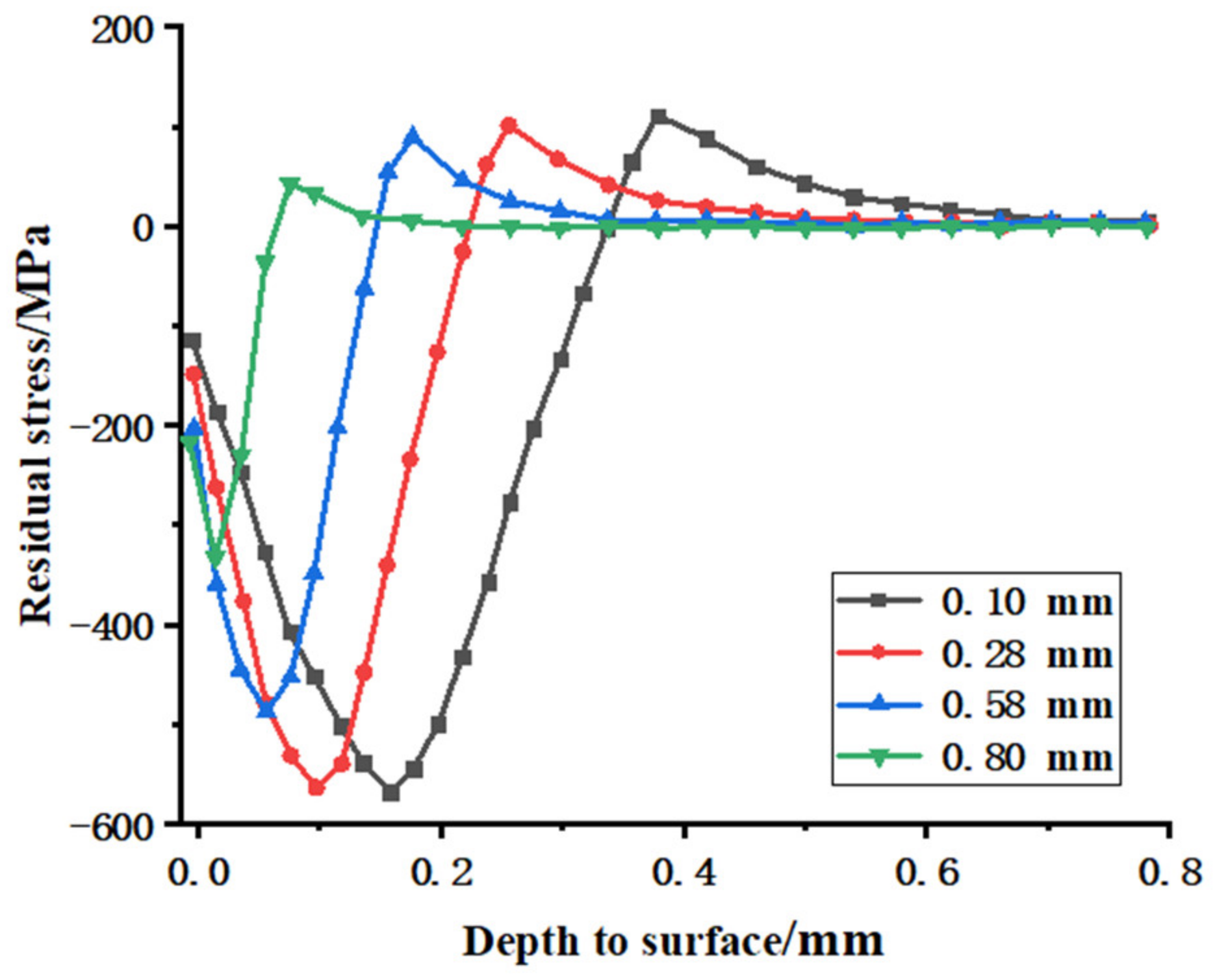
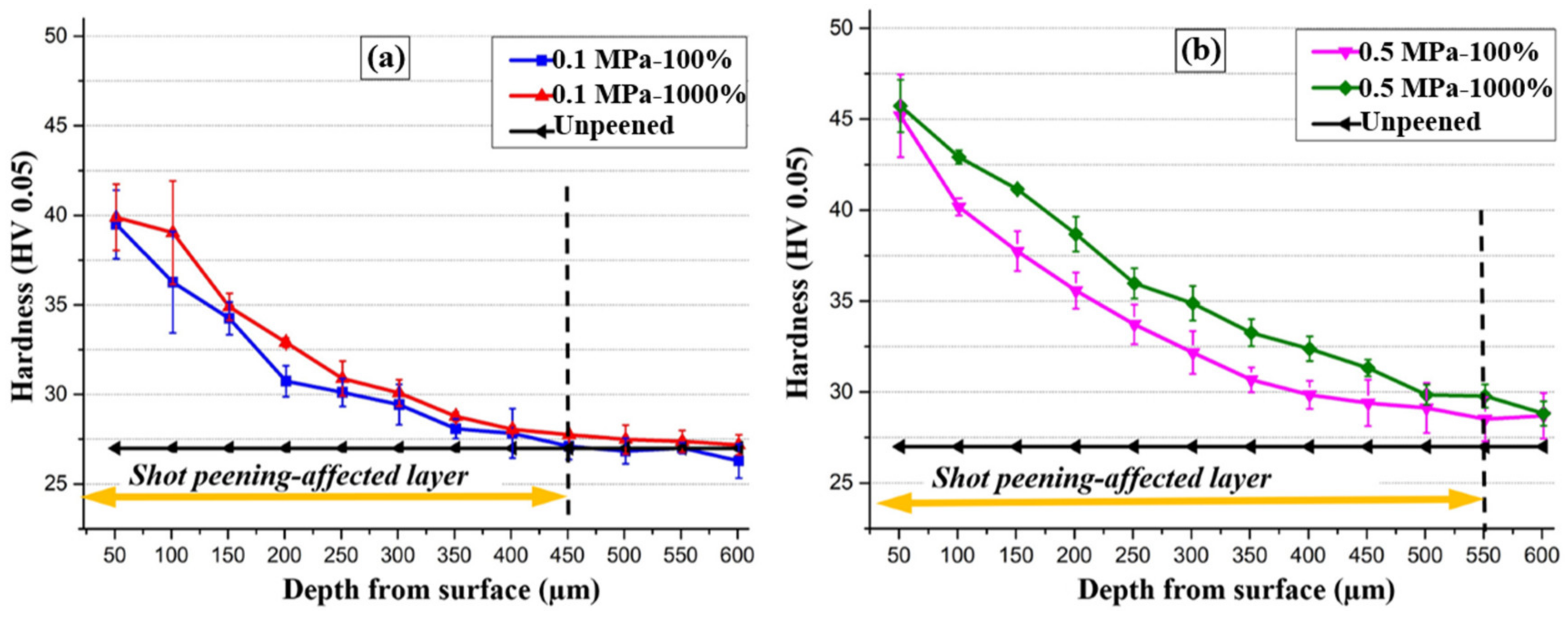
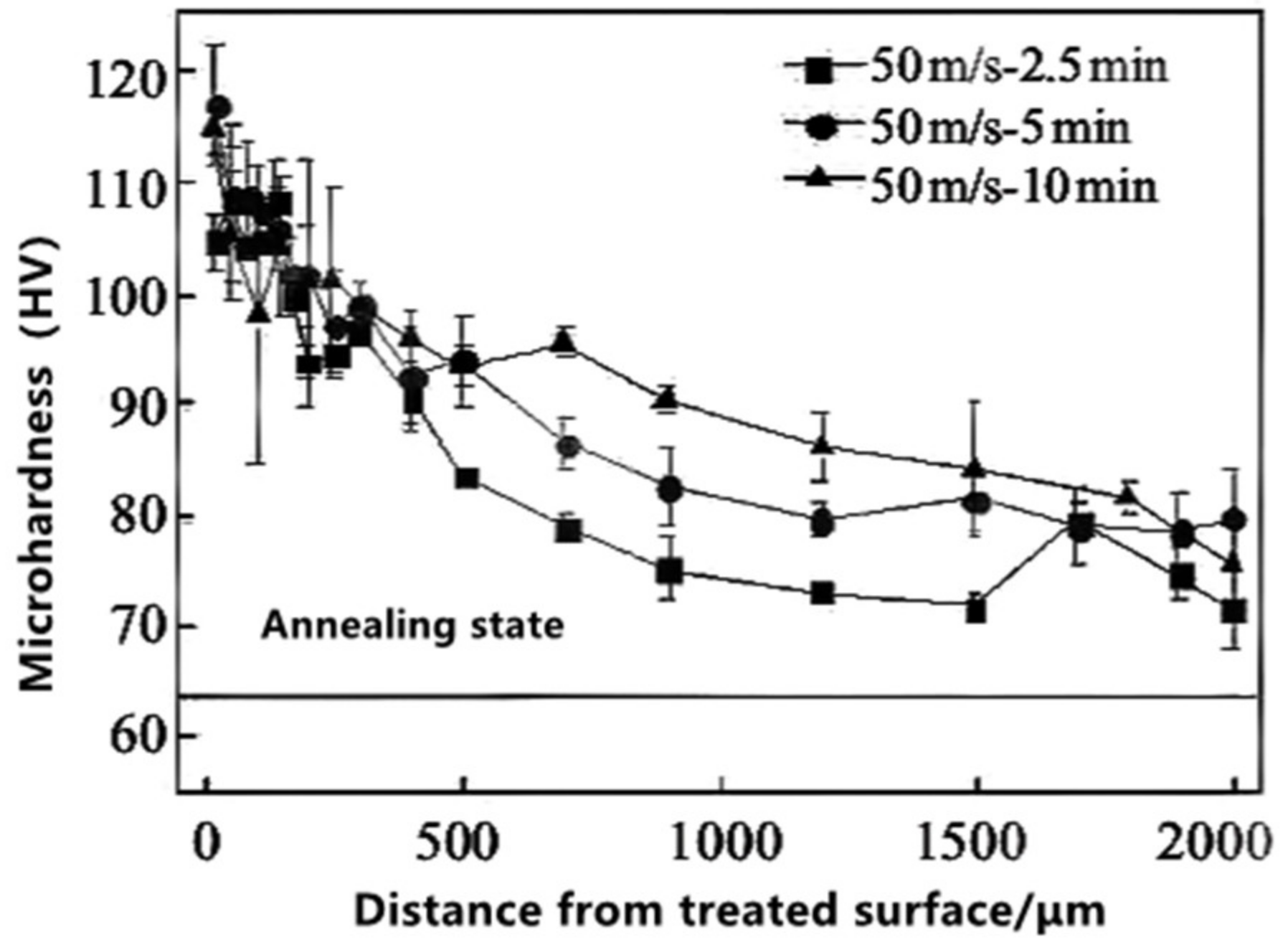
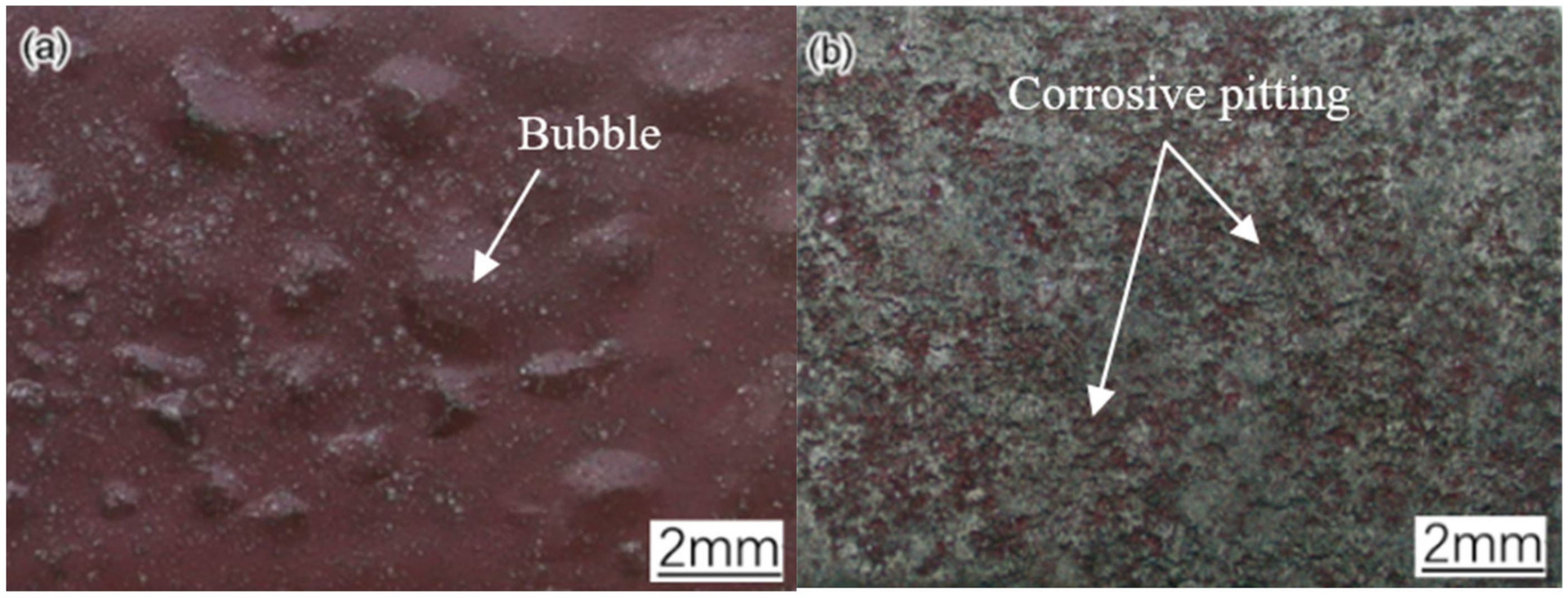

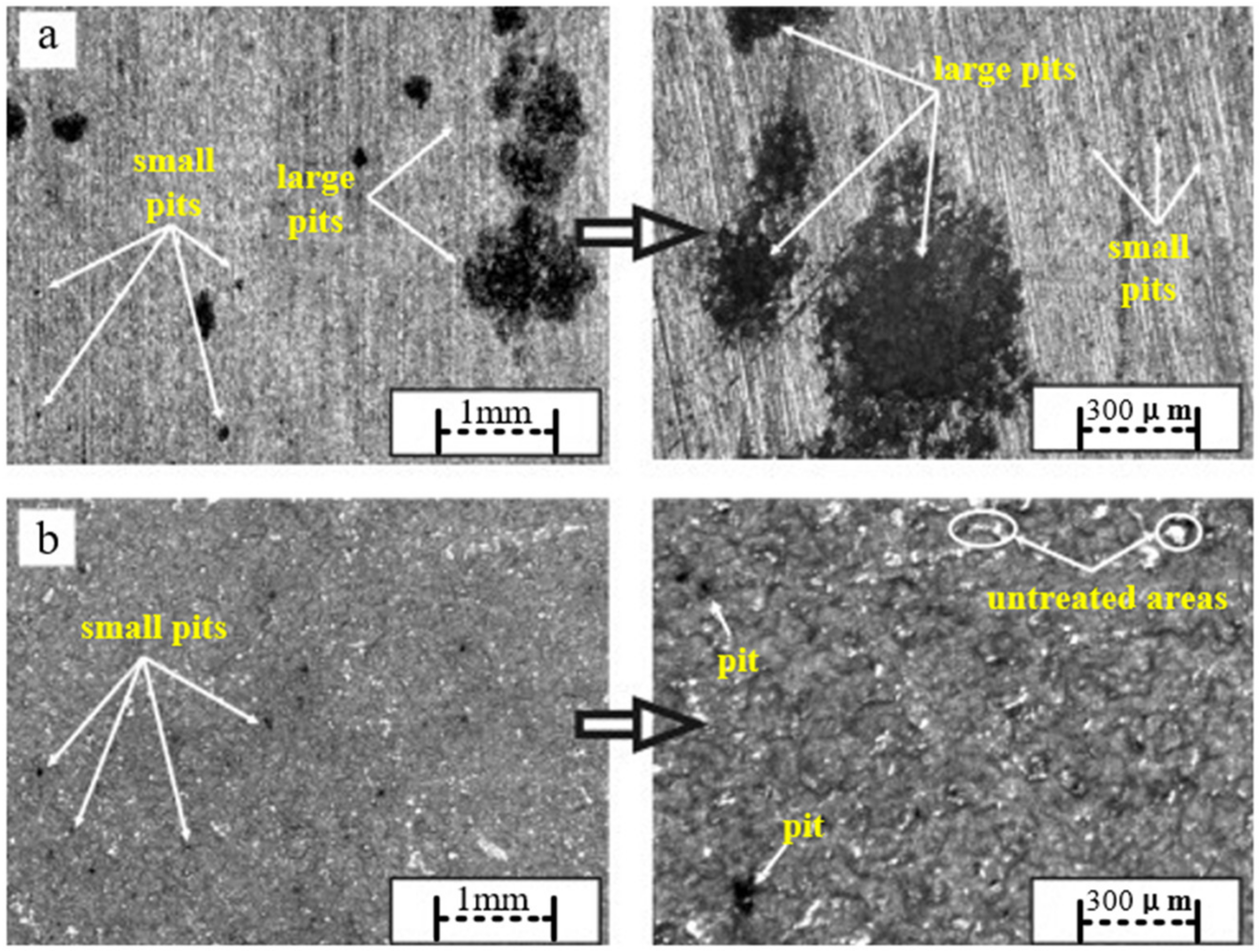
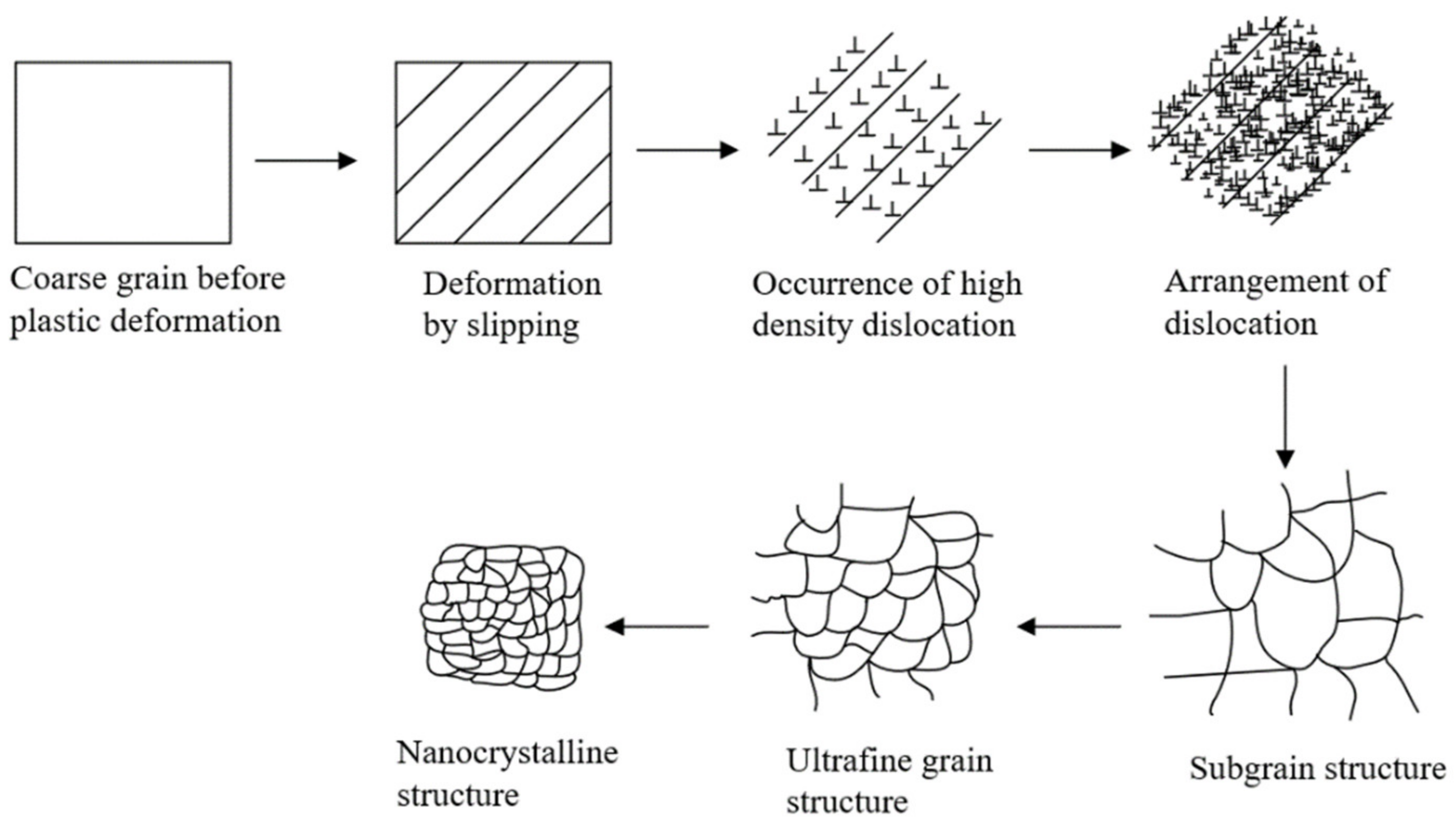
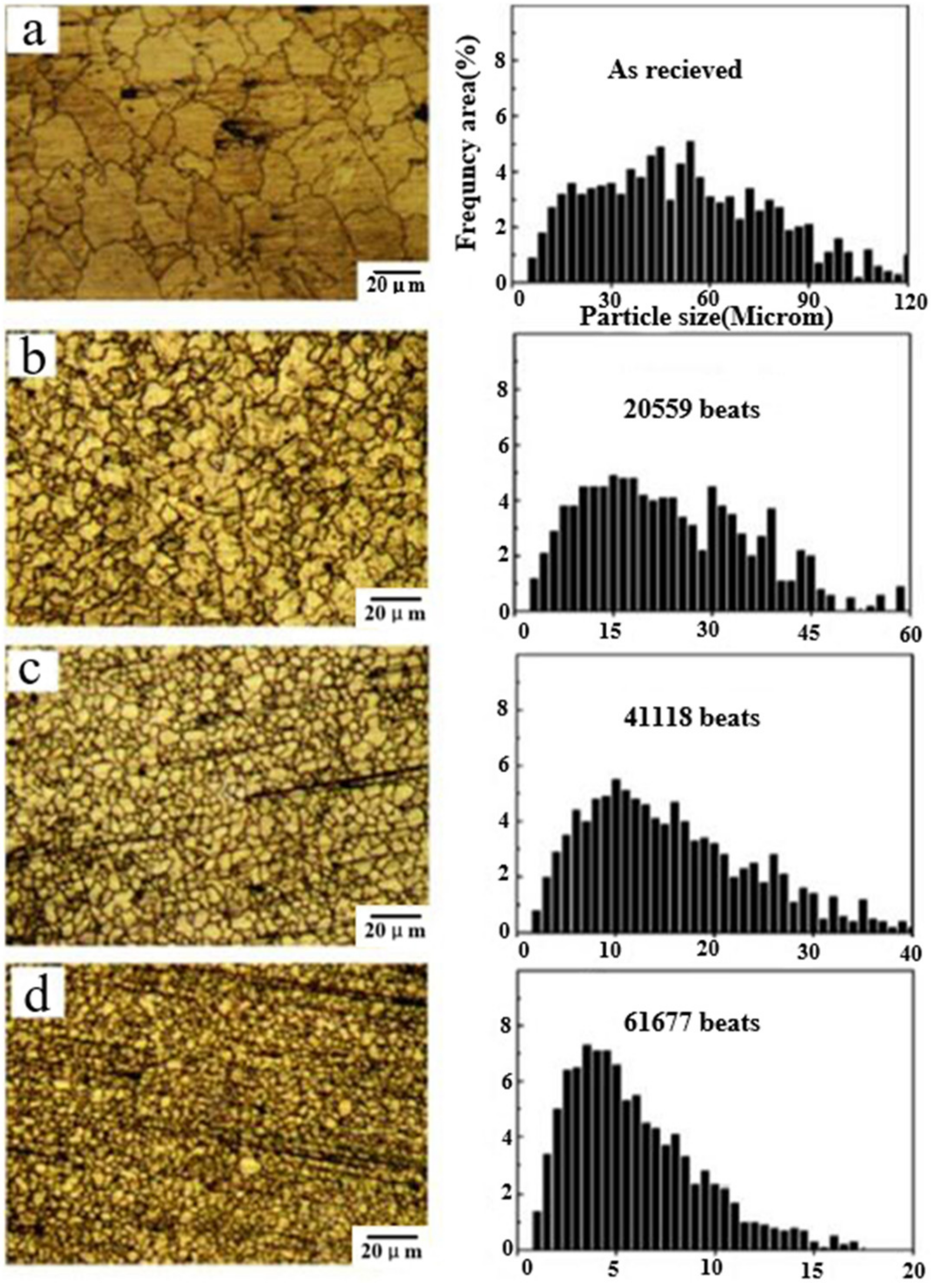
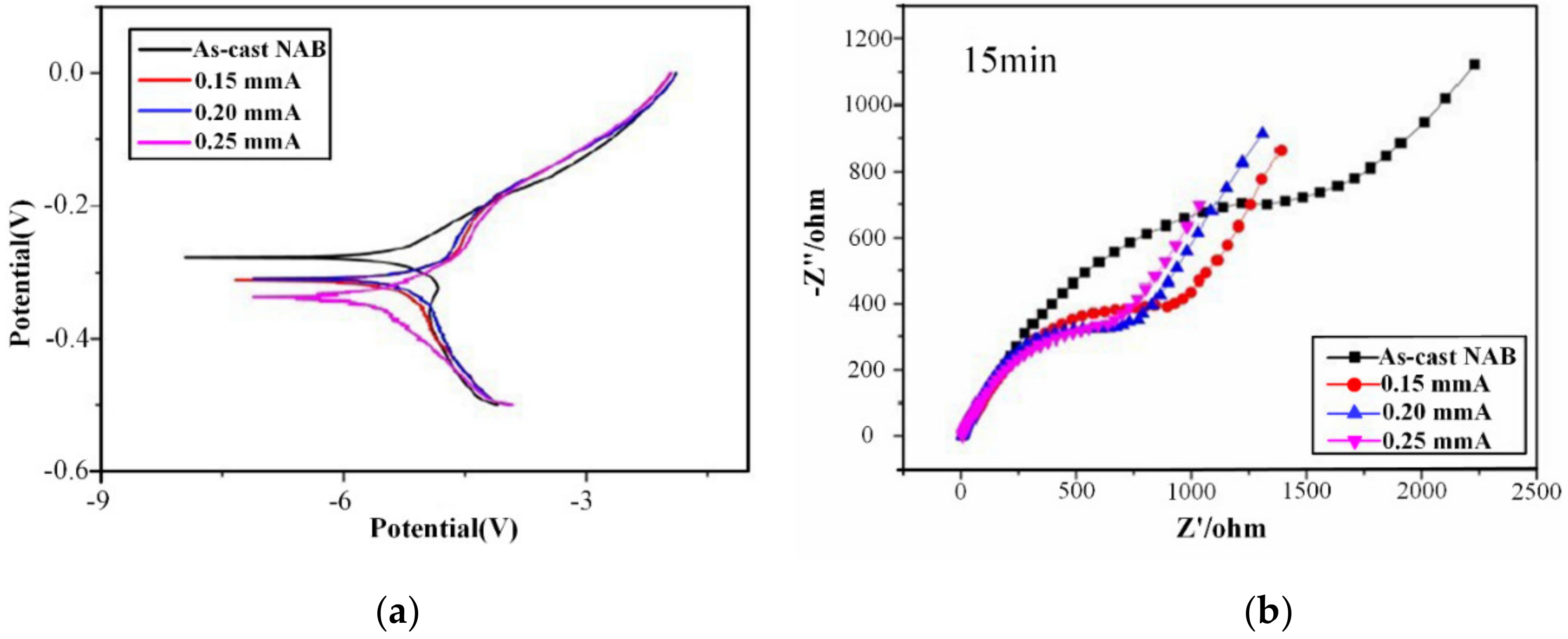
| Variety | Impact Medium | Parameter | Characteristics |
|---|---|---|---|
| Shot peening | Shot | Shot material and size Almen intensity Surface coverage Impact angle | The size and shape of the to-be-treated work piece with fewer restrictions, ease of operation as well as high production rate. |
| Laser shock peening | Laser beam | Power density Pulse duration Absorbent coating | Better surface finish, higher depths of residual stress and uniform distribution of intensity. |
| Ultrasonic shot peening | Spherical tip/Shot | Frequency Amplitude Static load Ball diameter | The equipment has the advantages of small volume, low energy consumption and environmental protection. |
| High-pressure waterjet shot peening | Mixed water beam mixed with shot | Supply pressure Jet exposure time Nozzle traverse rate | Simpler control over the process, full coverage of the treated area, flexibility in treating complex areas and ecofriendly environment. |
| Materials | Parameters | Before Treatment | After Treatment |
|---|---|---|---|
| 2124-T851 [40] | Surface roughness Ra (μm) | 0.75 | 7.20 |
| AlSi10Mg [18] | Residual stress (MPa) | 7.7 ± 5 | −152.5 ± 7 |
| 7475-T7351 [41] | Maximum residual stress depth (μm/beneath the surface) | 0 | 45 |
| AA2024 [29] | Surface microhardness (HV) | 65 | 140 |
| Materials | Corrosion Parameters | Before Treatment | After Treatment | Conclusion |
|---|---|---|---|---|
| AA7075 [62] | corrosion rate (μm/year) | 44.19 | 20.06 | Shot peening process can significantly reduce the corrosion rate of samples. |
| AA2024 [63] | corrosion depth (μm) | 192 ± 54 | 107 ± 30 | Shot peening process can significantly reduce the depth of corrosion. |
| AA7150 [64] | corrosion potential (V) | −0.775 | −0.739 | Pitting potential shifts to the more anodic direction after shot peening process, indicating an improved initiation resistance of localized corrosion. |
| AISI 304SS [65] | corrosion current density (μA/cm2) | 0.9 | 0.3 | After shot peening process, the corrosion current density decreased compared to that of the original sample. |
Publisher’s Note: MDPI stays neutral with regard to jurisdictional claims in published maps and institutional affiliations. |
© 2022 by the authors. Licensee MDPI, Basel, Switzerland. This article is an open access article distributed under the terms and conditions of the Creative Commons Attribution (CC BY) license (https://creativecommons.org/licenses/by/4.0/).
Share and Cite
Huang, H.; Niu, J.; Xing, X.; Lin, Q.; Chen, H.; Qiao, Y. Effects of the Shot Peening Process on Corrosion Resistance of Aluminum Alloy: A Review. Coatings 2022, 12, 629. https://doi.org/10.3390/coatings12050629
Huang H, Niu J, Xing X, Lin Q, Chen H, Qiao Y. Effects of the Shot Peening Process on Corrosion Resistance of Aluminum Alloy: A Review. Coatings. 2022; 12(5):629. https://doi.org/10.3390/coatings12050629
Chicago/Turabian StyleHuang, Hao, Jintao Niu, Xiangtao Xing, Qichao Lin, Hongtang Chen, and Yang Qiao. 2022. "Effects of the Shot Peening Process on Corrosion Resistance of Aluminum Alloy: A Review" Coatings 12, no. 5: 629. https://doi.org/10.3390/coatings12050629
APA StyleHuang, H., Niu, J., Xing, X., Lin, Q., Chen, H., & Qiao, Y. (2022). Effects of the Shot Peening Process on Corrosion Resistance of Aluminum Alloy: A Review. Coatings, 12(5), 629. https://doi.org/10.3390/coatings12050629






